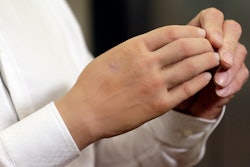The Ski-Cross Rocketeer
Athletes just cannot be too extreme these days. After all, if you're not defying death, how are you going to lock up that Red Bull sponsorship, and development deal with Red Bull TV?
Now, we've seen a few jetpack designs in the last year, and the hydro jetpack is a tourist trap for anyone who can make the weight limit, but one Slovenian freestyle skier is redefining the term "jetski."
This week, Red Bull released a video of ski-cross world champion Filip Flisar clipping into his skis and strapping on a jetpack.
According to Red Bull, the jetpack can run at up to 96,000 rpm, and produce a jet blast that reaches up to 850°C. With the pack, Flisar can speed through the slopes of Slovenia at more than 75 mph.
It could be the next tourist trap, though I wonder what the deposit would be for a jetpack.
Group Gets $4.63 Million for Tidal Energy Concept
Led by Nova Innovation in Scotland, a European tidal energy consortium received $4.63 million in grant funding from the European Commission for its direct drive power take-off (PTO) solution for tidal turbines.
The funding comes from the European Union’s Horizon 2020 Framework that has dedicated more than $1 billion to supporting energy-related research and innovation in 2016-2017.
According to the group behind the tidal tech, the system could reduce the lifetime cost of tidal power by 20% and provide long term system reliability.
The project is called TiPA (Tidal turbine Power take-off Accelerator), and they plan to achieve cost savings buy replacing a conventional power take-off with an advanced direct drive PTO. The PTO subsystem is the component that transforms the mechanical power in the tidal turbine rotor into electricity that is exported into the grid.
Basically, they are going to replace the gearbox and conventional generator in the turbine with a PTO that has a direct drive generator. The group hopes the direct-drive PTO will increase the commercial viability of tidal turbines by reducing the cost of operation and maintenance.
The project will run for 36 months, which should give the team enough time to build the new PTO and conduct accelerated onshore testing in Germany followed by in-sea testing in Scotland with third party validation of the design and the test results. They'll likely test it off the coast of the Shetland Islands, where Nova Innovation already has a pair of 100 kW tidal turbines installed.
The consortium has brought together some heavy hitters in the industry. While Nova Innovation will work on the generator, Siemens is tasked with the power electronics; SKF is working on the bearing and seals, and the University of Edinburgh will work on the modeling.
After three years, and if the technology is proven capable, the group will commercialize the product to be licensed and sold. After all, what good is new technology unless you can profit from it?
Man Quits His Job to Build His Son a New Arm
When Ben Ryan’s son, Sol Ryan, was born, a complication at birth resulted in the amputation of most of his lower left arm. According to the National Health Service in the UK, it would be three years before Sol would receive a myoelectric prosthetic, and a full year before he was fit with a cosmetic, non-functional prosthesis.
Ben couldn’t sit and watch as his son lost responsiveness to his left arm, so he did what any father would do, he quit his 12-year career as a teacher, and taught himself out to make Sol new prosthetic arm. The man built his son a limb; he’s a hero.
When his son was just five weeks old, Ben built Sol’s first prosthetic out of a sponge and a bandage. It wasn’t an ideal long-term solution, so the ambitious father taught himself how to use Autodesk Fusion 360, and designed a hydraulic prosthetic arm that he 3D printed on a Stratasys Connex 3D Printer.
The lightweight design weighs less than traditional alternatives, and it’s body-powered, which means that it uses fluid in the socket to actuate the grip on the hand. With Ben’s new design, infants like Sol can grow accustomed to their new arm earlier than traditional fittings.
The NHS would have taken 11 weeks to turn a plaster cast into a wearable prosthetic. Ben’s new design can be built in five days.
He spun his patented technology into a new company, Ambionics. And while his family has supported his new role as founder and CEO, the money has dried up and he is desperate for a cash infusion.
Yesterday, he launched a crowdfunding campaign on IndieGogo to keep his new company and dream afloat. He is hoping to raise around $184,000.
While he has had offers from traditional investors, he needs to move faster to bring his product to market. He needs $98K for usability trials to try and secure CE and FDA approval; $60,000 to $74,000 for prototyping and product development costs, and $30,000 to protect the patent, and commercialize the business.
This is Engineering By Design with David Mantey.






















